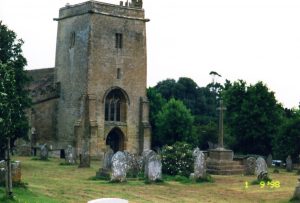All Saints Church and it’s Vicars
There is a separate page now for All Saints Vicars and Incumbents here.
There has been a church existing in Merriott from earliest times (some say from Saxon times), but certainly there was a church in Merriott before the time of the Domesday Book.
The Church of All Saints was originally built in the 13th century by Sir John de Meriet, next to his manor house. His infant son John was the first to be baptised there in 1276. The Church was dedicated as ALL SAINTS by the middle of the 13th century. Merriott’s first Incumbents were Rectors, not Vicars. The Lords of the Manor then held the appointment of the incumbent, and all the tythes were devoted towards his upkeep. One John de Meriet sold the right (later called the “gift of the living”) to the Bishop of Bath and Wells who, in turn, sold it to Muchelney Abbey.
The Church is built of rubble & ashlar, and has a chancel with north & south chapels, aisled nave with south porch, and west tower. Although parts of the church today date back to the 13th century, there were also later additions in the 14th, 15th and 16th centuries. Part of the church was demolished in 1860 & new extensions built. At this time, the entire church was also refurnished.
Sources: Victoria County History of Somerset, Vol IV; An Ancient English Village – Merriott, Somerset;
A History of Merriott Village and Church
The Somerset Record Office holds the following item: DD/rg/313 Glebe terriers for Merriott. [A terrier is a survey; the Glebe is the land or property held by the Church of England Vicar for the support of himself and his church]
Description: Vicarage house, barn, outhouses, orchard, garden, barton, dwellinghouse with court, barn, stable, stall, malthouse, orchard, garden.

Above: Photo Courtesy of Pauline Phillips, 1995

Above: Photo courtesy of Joyce & Les Farmer, 1998

Above: Photo courtesy of Linda Haylock

If you look closely at the picture above, you can see the small illuminated object at the bottom centre of the stained glass window behind the altar. That is the medieval cross which was found in the ground alongside the church foundation during a renovation some years ago. It is thought to be from a previous church on this site, pre- 1200s. Also there are small stone angels or cherubs at the ends of many of the ceiling wooden posts. They all look down on the congregation.
Photo and comment courtesy of Barb Dembinski.
Pictures from John Chant 2003
Thank you John.
Some Pictures and Notes from Brian Tasker
Thank you Brian.
Looking up my own photos of the War Memorial taken in the spring of 1997 I found with them my pictures of All Saints Church. The actual War Memorial being in the churchyard – the large cross in the left of All Saints 1. A very long time ago now that I was able to look from the top of that Church tower. For some reason on a few occasions as members of the choir we were allowed up the tower after morning service.
While I was pleased to take these pictures of the church, it was for me very sad that I could only get these views because the majestic line of lime trees which used
to front the churchyard wall had become decimated. The trees used to be all the way along. In the Autumn we used to scuff through the leaves on the way to school, but the best memory is of the sticky flowers falling in the Spring with their perfume and the incessant buzz of the bees high in the trees.
I cannot leave this corner without reference to ” The Pebble” . I too, took the trouble to photograph this as it remains such a feature of Merriott. Another name we had for it was the “Butt Stone” –why I never knew. As far as I know it had no relationship with the game of marbles we used to play called “Butts”. I would dearly like to know the origin of the stone, and when it settled in its present position. I only hope that present-day Merriott will respect it and leave it be !!
Anyway what sort of stone is it ?? I always believed it was a giant Flint and knowing how flints split to show a totally different interior I believed that the stone could contain some magical secret within it. Even in later years I wondered if its unusualness and position was as some sort of boundary stone in the Ley-line tradition. All that mattered when we were children was that it was the meeting corner outside the school, it could become a bus, a boat, or even an island in our play. We could sit on it to enjoy our sweets – Sherbert Dabs, Bootlace Liquorice, Comfits, or Palm Toffee. Long may it remain !!!
Regards, Brian